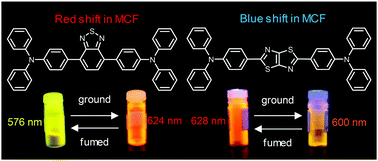Mechanochromic fluorescence based on a combination of acceptor and bulky donor moieties: tuning emission color and regulating emission change direction†
Abstract
Mechanical stimuli-responsive fluorescence changes, a phenomenon referred to as mechanochromic fluorescence (MCF), have attracted much interest in novel materials and biological applications. Herein, we report MCF based on a donor–acceptor structure bearing nonplanar donor moieties that allows the tuning of emission color and regulation of emission change direction. The MCF is demonstrated using a series of triphenylamine-based donor–acceptor dyes. The fluorescence wavelength can be tuned by the strength of the donor–acceptor conjugation, yielding blue to deep-red fluorescence. The twisted conformation as well as the continuous internal space created by the steric demand of the donor moieties enables rearrangement of the crystal packing upon mechanical grinding, leading to fluorescence changes. The bathochromic and hypsochromic shifts in MCF are regulated by the presence or absence of stacking interactions with the central acceptor moiety.



 Please wait while we load your content...
Please wait while we load your content...